This story was originally published on July 8, 2012.
MILLTOWN, New Brunswick – It’s late in the alewives’ spring run, and overnight just five fish have climbed the fish ladder at the Milltown Dam, which spans the St. Croix River on the Maine-New Brunswick border.
At the top of the ladder, which climbs around the back of the 131-year-old dam, the fish are waiting in a cagelike trap when Lee Sochasky arrives to count and release them. One 10-inch female — fish No. 36,168 of the season — is kept for scientific analysis. Big, healthy and filled with eggs, she is likely 5 years old, meaning she hatched in the straight stretch of river between here and the Woodland Dam, 10 miles upstream. In the intervening years she has likely traveled to Georges Bank and possibly as far south as North Carolina. This spring she — and 36,000 other alewives — headed home to the St. Croix to reproduce.
If the fish’s advocates have their way, in future years she might be part of spring runs numbering in the millions.
Not everyone is happy the alewives are here, and others don’t want to see their numbers grow. Some see them as an invasive pest that could undermine the ecology of the lakes and streams of the sprawling St. Croix basin, wiping out the sport fisheries on its many lakes and ponds. Others hold they are not only native to the St. Croix, they are essential to its restoration, a forage fish key to rebuilding populations of everything from salmon to cod.
The humble fish are now the subject of a federal lawsuit, a diplomatic appeal to an international body and a state of emergency declared by three chiefs of the Passamaquoddy tribe, who want the fish restored.
The future of the alewife runs — currently confined to the lowest stretch of the river on orders of the Maine Legislature — will likely be decided in Augusta, and lawmakers can expect to hear an earful. At stake is the ecological future of a 1,600-square-mile swath of lakes, rivers and forests in Maine and New Brunswick and an even greater expanse of undersea habitat in eastern Maine.
“This is as if you were honoring a mother who was nine months pregnant and wants to go to a hospital,” says Clayton Cleaves, chief of the Pleasant Point band of the Passamaquoddy Tribe, the native people of the St. Croix watershed. “Can you imagine if that mother was blocked from the hospital door? You’d have a riot.”
“Alewives are ferocious and they kill a lake by eating all the plankton the other fish need to grow,” counters Lance Wheaton, a fifth-generation fishing guide and owner of The Village Camps in Forest City, some 60 miles upriver, who has fought hard to keep the fish out. “I understand ocean fishermen need them for lobster bait, but what they’re going to do is put all of us inland onto welfare.”
Currently, the alewives are blocked from passing beyond the Grand Falls Dam, 19 miles north of here, on the orders of the Maine Legislature. An estimated 94 percent of their potential spawning habitat lies above that dam.
The 17-year battle over the fish’s future has heated up in recent weeks. On May 31, the Conservation Law Foundation filed a lawsuit against the U.S. Environmental Protection Agency to compel it to force Maine to let the alewives through on the grounds that not doing so violates the Clean Water Act. Another environmental group, the Richmond-based Friends of Merrymeeting Bay, has announced plans to sue the EPA as well.
Once divided on the issue, the Passamaquoddy have engaged in a full-court press to open the river to alewives. In May, they petitioned the International Joint Commission — the bilateral organization that coordinates activity on the shared international waterway — to open the Grand Falls Dam. Environmental groups have argued for years that the commission has the power to do so under a 1909 boundary treaty.
In early June, a dozen tribe members participated in a two-day, 100-mile spiritual run to draw attention to the issue. The following week, the tribe’s three chiefs declared a “state of emergency” and demanded the state “immediately remove this blockage and allow these fish to pass.” The chiefs of the state’s Penobscots, Maliseets and Micmacs joined them as signatories to a June 21 letter to Gov. Paul LePage urging him to support their forthcoming effort to get the state Legislature to reverse itself.
“This is, in fact, a natural disaster,” says Vera Francis, a Passamaquoddy environmental activist at Pleasant Point. “It is our (chiefs’) duty to stop the potential destruction of a species — (something) that denies us access to food and sustenance.”
“Quite frankly, it’s scientifically, economically and legally unsupportable for the state to have this law on the books that prevents the dam owners from operating perfectly good and efficient fish passages on the St. Croix,” says Sean Mahoney, director of the Conservation Law Foundation’s Maine office.
1995 MAINE LAW CLOSED FISHWAYS
How did it come to this?
From 1825 until the modern fishway here in Milltown was built in 1981, alewives had trouble getting into the river. Those that did encountered a toxic environment until the late 1970s, when the paper plant at Woodland installed new pollution controls in accordance with the federal Clean Water Act. Fewer than 200,000 fish passed Milltown each year toward the end of this period.
But with cleaner water and a better fishway, alewives began a stunning recovery. Between 1981 and 1987, their annual run grew thirteenfold to more than 2.6 million. Alewives traversed pre-existing fishways at the Woodland and Grand Falls dams to spawn in Spednik Lake (near Vanceboro) and Big Lake (below Grand Lake Stream).
Then lawmakers in Augusta stepped in, passing a 1995 law that ordered the fishways at Woodland and Grand Falls to be closed to alewives. The St. Croix alewife runs collapsed to just 900 fish in 2002, a fall of 99.7 percent. “If you wanted a law that was effective in extirpating alewives from their native habitat, that law worked,” says Mahoney.
That was precisely the intention of the aptly named Act to Stop the Alewives Restoration Program in the St. Croix River. Alewives, lawmakers held, would harm the smallmouth bass fishery in area lakes by competing for food. Fishing guides pointed to the sudden collapse of the bass population in Spednik Lake, the body of water created by the Vanceboro Dam, as evidence of the destructive power of alewives, which they claimed were an invasive species that never lived in the river.
“Salmon Falls at Milltown was a natural barrier to the sea,” says Wheaton, who insists alewives never entered even the lowest range of the river. “These were a tremendous set of falls and all of the research shows the Indians always had to go below Salmon Falls to get their alewives.”
EVIDENCE SUGGESTS ALEWIVES WERE NATIVE
Subsequent research cast doubt on the guides’ assertions. The Spednik Lake bass crash appears to have been at least partly the result of the Vanceboro Dam operator having lowered the lake’s level at an inopportune time for the bass, leaving their egg nests high and dry.
Smallmouth bass — themselves introduced into the St. Croix in 1877 — and sea-run alewives were shown to have lived harmoniously in hundreds of Maine rivers and lakes. Archaeological, documentary and topographic evidence suggests alewives were native to much of the watershed prior to the first, fish-impassable dams being built in 1825, a position endorsed by the government of Canada and the St. Croix board of the International Joint Commission. Early 19th-century alewife runs at Milltown were described by witnesses as coming in “such quantities that it was supposed they never could be destroyed,” according to an official 1852 report by the New Brunswick government.
“The evidence we looked at said that we had alewives in the St. Croix beforehand and that other (river) systems have had high numbers of alewives and bass populations at the same time,” says George Lapointe, who headed the Maine Department of Marine Resources from 1998 to 2010. “Alewives provide the Purina Chow for the ecosystem, providing food for smallmouth bass and big game fish and really for everything.”
“Washington County is the poorest county in Maine, and if you restored the alewives you are talking about millions of dollars of income to small artisanal harvesters throughout the system,” says Ted Ames of the Stonington-based Penobscot East Resource Center, a MacArthur Genius Grant winner who has researched the ecological impact of alewives in Maine. “It’s like a Pandora’s box, but one where all sorts of good things happen if you open it.”
The alewives, Ames has predicted, would boost inland and marine fish populations (by being eaten by them), improve water quality on the lakes (by helping to consume the summer plankton blooms), improving life for guides and marine fishermen alike. “There are people who still think the world is flat, and you can’t dissuade them of it,” he says of the counter-arguments. “The science doesn’t even enter into it.”
LEGISLATURE TAKES ANOTHER LOOK
As the evidence accumulated, the Legislature revisited the issue in 2008. Guides and municipal officials from northern Washington County opposed the idea of allowing the fish to travel farther upstream; the Canadian government, environmental groups, lobstermen and the chief of the Pleasant Point Passamaquoddies supported it. Scientific papers submitted to the committee also supported opening the fishways, although a Maine Department of Inland Fisheries and Wildlife biologist argued they should not be allowed over the Grand Lake Stream Dam on the west branch of the watershed for fear they would complicate management of local landlocked salmon and the smelt they prefer to eat.
With Gov. John Baldacci behind the plan, “we were all set to go,” recalls the bill’s sponsor, Sen. Dennis Damon, D-Trenton, then a state senator and co-chair of the committee. “Then suddenly, a half hour before the hearing, the (administration) changed their position.”
Damon and other observers say one man managed to turn Baldacci against the alewives: Bill Nicholas, then chief of the Indian Township band of Passamaquoddy, whose reservation is located near Big Lake. In meetings with the governor and in forceful committee testimony, Nicholas argued the alewives had never been in the river and never should be, and left many listeners with the impression he spoke for the tribe as a whole.
His speeches were compelling, Damon says, and ultimately legislators took only a baby step, ordering the Woodland Dam opened, but keeping Grand Falls closed, a net gain to the alewives of just nine miles of riverbed.
“In military parlance, it’s called a command performance,” says Paul Bisulca, a West Point graduate who at the time was chairman of the Maine Indian Tribal-State Commission, which represents all of Maine’s tribes. “(Nicholas) went into that hearing and without any doubt represented the Passamaquoddy Tribe completely. How Billy was able to manipulate those people is beyond me, but there are some who can do it.”
“We’ve had elders at Indian Township — the freshwater part of the Passamaquoddy Tribes — who have testified in the past that there were not alewives in our waters until the fish ladders were put in,” says Nicholas, who is no longer chief, but stands by his position. “Our elders were very, very knowledgeable, so I’m not going to go against that information that was provided to us by someone 100 years old.”
“No one has been able to provide information that’s credible that alewives made it above Grand Falls,” he adds, calling them “the grandest, steepest falls in the river.”
That final argument caught the interest of Ed Bassett, a member of the Pleasant Point band who now serves on the Passamaquoddy tribal council and had experience adjusting fishways for alewives. Over the past two years, he researched Nicholas’ claims, the history of the river’s alewives, and visited the Grand Falls dam site, where he found and walked the original riverbed where the falls were before 1905, when the dam was built and the river diverted.
“I know the kind of fish they are and the strength they have, and when I found the original channel that’s when I realized something was wrong,” says Bassett, who says the falls were deemed “grand” because of their length, not their height. “I remember thinking: this is wrong. This needs to be exposed.”
TRIBAL OPINION SHIFTS ON ALEWIVES
The result was an hour-and-a-half-long video detailing the case for alewives being a native species, and accusing Nicholas of misleading the tribe and state. The video — targeted at fellow tribe members — has apparently shifted tribal public opinion in favor of the fish. “People have been afraid to talk, afraid that if you speak your mind there will be consequences, and that’s even greater if you speak to the power structure,” says Bassett, who hopes the video is helping undo that dynamic.
“Nicholas owes the entire tribe an apology,” says Francis, the Passamaquoddy environmental activist. who says many tribal elders attested to the presence of alewives in the river. (The competing accounts are over oral history, not eyewitness testimony, as the dams blocked alewives from entering the river after 1825, nearly a century before the birth of the oldest living elders.)
Nicholas stands by his account. “They must be pretty desperate to be putting out a video to defame me when I have no power or authority to do anything,” says the former chief. “You’re talking about a very invasive species that could kill the fishery in our area.”
The guides also remain adamant, and are unconvinced that big runs of fish won’t harm the bass and landlocked salmon on which their rural region depends. “If the alewives come upstream and devastate the fisheries, your camp will only be worth half as much,” says Wheaton. “My life is almost over — I’m 67 or 68 — but all those young families, I hate to think of it.”
“Even by Washington County standards there is almost no economy up there — sports camps are all there is,” says Senate President Kevin Raye, R-Perry, who represents the region and opposes opening the fishways. (The sprawling county has just 32,000 residents.) “If this proceeds, I hope and pray that those who are so confident are right, because if there is a mistake made it will be absolutely devastating for (the northern part of the county) to recover from it.”
There is a third option, though few on either side speak of it, says Joan Garner Trial, a member of the regional IJC board. Since 2008, the IJC has overseen the creation of a compromise solution, an “adaptive management plan” that would let the alewives into more of the watershed, while carefully monitoring their effects on the ecosystem and taking necessary steps to restrict their numbers if problems arise.
The plan — currently spurned by both sides — would allow the spawning alewives into the middle of the watershed, but prevent them from passing the next set of dams at Vanceboro (on the main river) and Grand Lake Stream (on the western branch). Biologists would carefully monitor the situation, stepping in to close fishways if alewives appeared to cause trouble at certain densities.
“The big question that keeps coming up as far as the (sea-run) alewives is whether they will have a positive or negative impact on inland fish populations,” says Gregory Burr, regional biologist with the local office of Maine Inland Fisheries and Wildlife in Jonesboro. “Truth is, we don’t know and there needs to be more studies on that.”
The adaptive management plan would do just that, he says, and has a model for protecting smallmouth bass in the main river and Big Lake if problems present themselves. “It really spells everything out.”
Whether the plan gets adopted remains to be seen, but legal and legislative action on the issue seems certain.
“The situation will come to an end soon,” Chief Cleaves predicts, “and it will come to an end in favor of the alewives.”
Staff Writer Colin Woodard can be contacted at 791-6317 or at:
cwoodard@mainetoday.com
Send questions/comments to the editors.

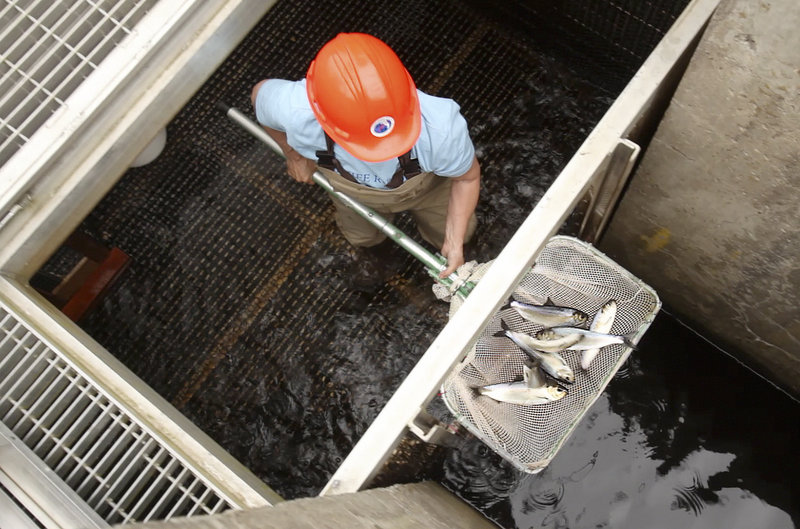
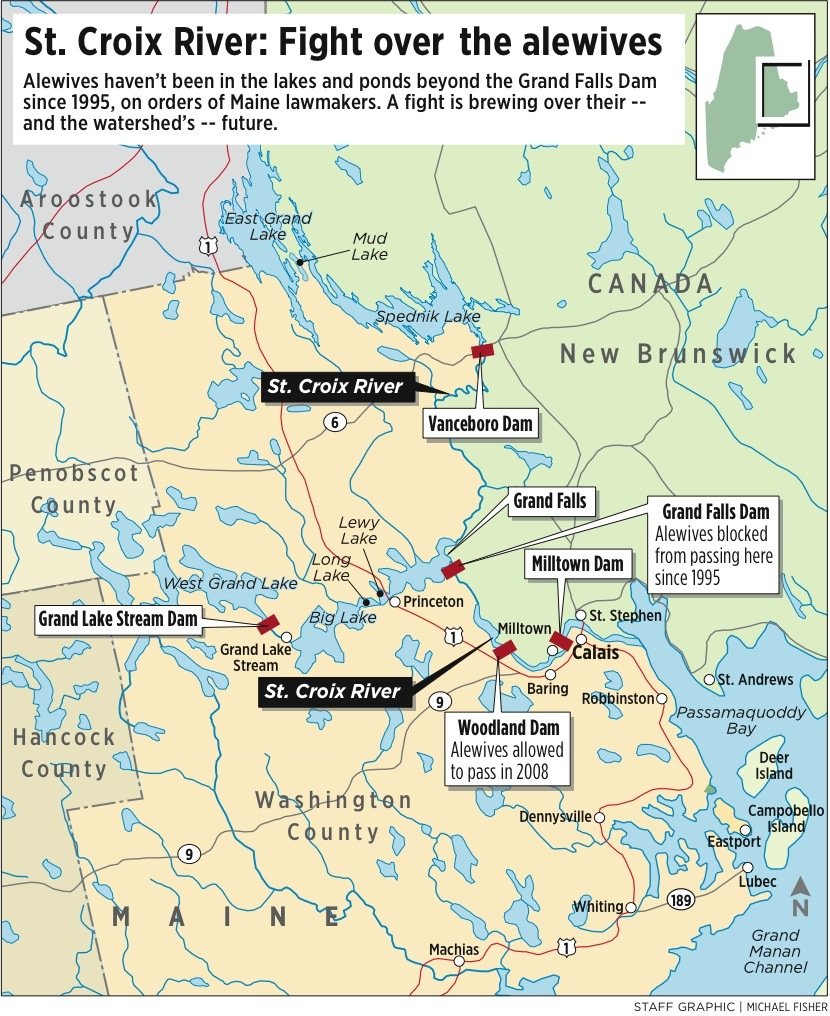

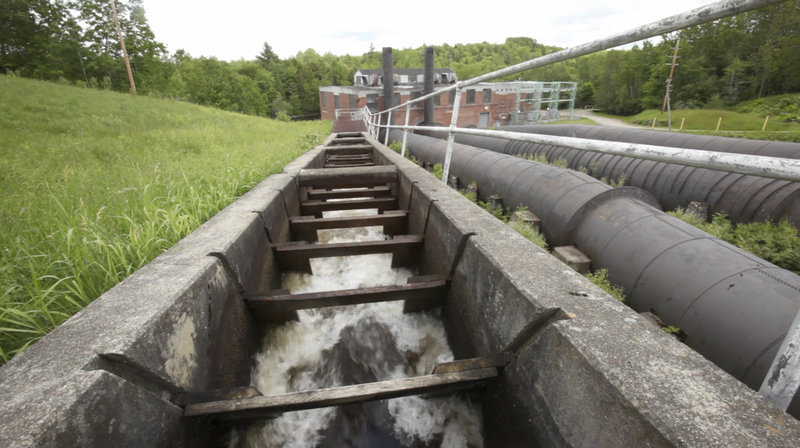
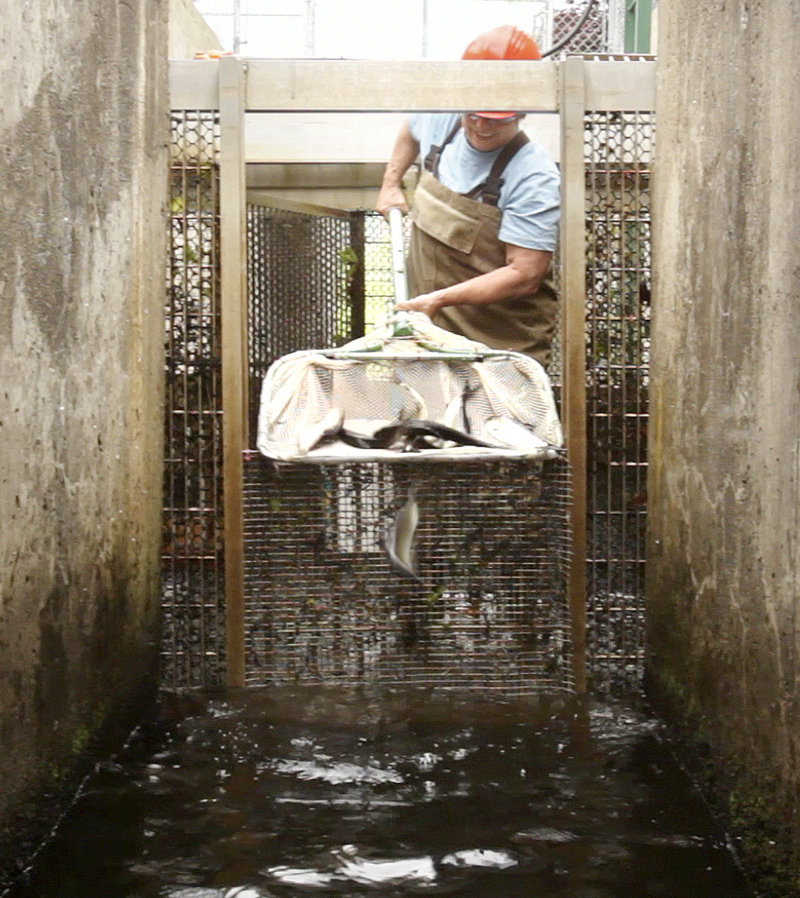
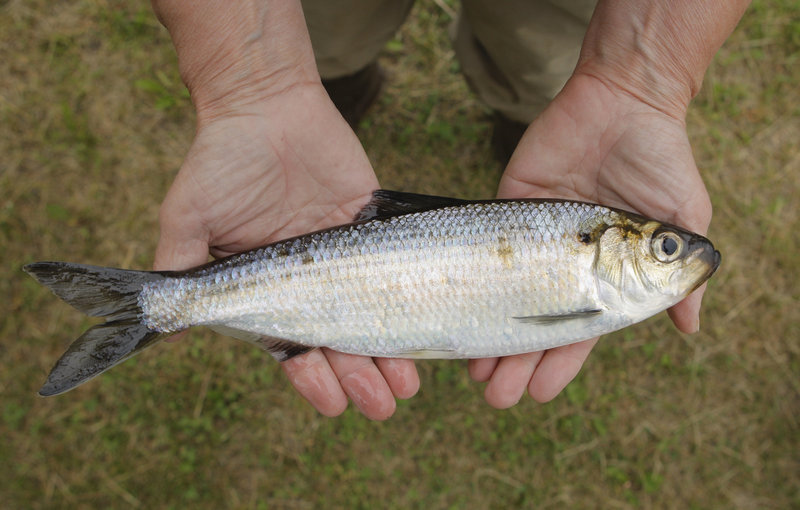


Success. Please wait for the page to reload. If the page does not reload within 5 seconds, please refresh the page.
Enter your email and password to access comments.
Hi, to comment on stories you must . This profile is in addition to your subscription and website login.
Already have a commenting profile? .
Invalid username/password.
Please check your email to confirm and complete your registration.
Only subscribers are eligible to post comments. Please subscribe or login first for digital access. Here’s why.
Use the form below to reset your password. When you've submitted your account email, we will send an email with a reset code.